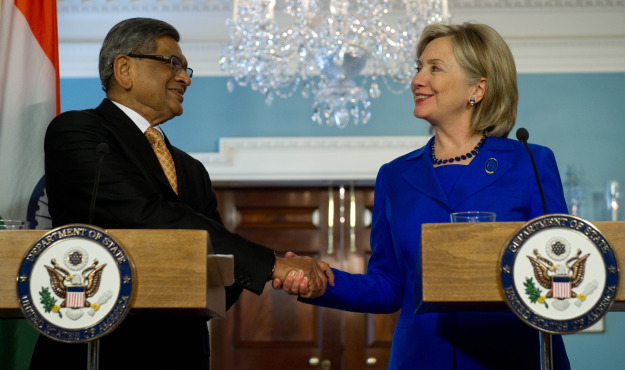
US and India attempted to thaw somewhat cooler relations with a strategic dialogue session this week in Washington, D.C. The US held similar dialogue sessions with Afghanistan and Pakistan earlier this year, but emphasized that the meeting with India was more similar to the “whole of government” sessions held with China and Brazil.
The dialogue, led by India’s External Affairs Minister S.M. Krishna and Secretary of State Hillary Clinton, discussed three main issues central to Indo-US relations: United Nations Security Council (UNSC) reform to include India as a permanent member, counter-terrorism cooperation and defense modernization. Other key takeaways included trade policies and education, specifically the issue of changing Indian law to allow foreign universities to open campuses in India.
The meeting was a chance for the US to re-establish warmer relations with India. The two countries have recently clashed over President Obama’s Af-Pak policy and America’s growing engagement with China. During the meeting, the US went out of its way to praise and woo India. Obama made a brief appearance to address the gathering, something widely commented on by the Indian media because he did not attend a similar session with Pakistan. In a speech, Undersecretary of State William J. Burns said, “Never has there been a moment when India and America mattered more to one another,” before adding that India’s rise is “deeply in the strategic interest of the U.S.”
The Administration also used the event to announce that the President would visit India this fall. On India’s part, Krishna promised the country would pass the nuclear liability law, which will limit the liability of U.S. firms operating nuclear plants in India. This step is essential for the final passage of the 2008 civil nuclear deal.
Despite this meeting seeming to be a virtual love fest, did the dialogue actually move the relationship forward or do the doubts between the two countries persist? The Obama Administration has made all the right noises about India’s strategic importance, but its actions speak another story altogether. In April, the Administration issued a secret directive to convince India to deal with Pakistan’s “perceptions” and “concerns,” which include Kashmir and India’s role in Afghanistan. Indians have also expressed increasing consternation over US restrictions on access to David Headley, who is alleged to have helped Lakshar e-Taiba plan the massacre in Mumbai.
This event was widely portrayed by the Indian media as an attempt by the Obama Administration to convince India that it was ready to go back to the good ol’ days of Bush’s love affair with India. A Times of India story inexplicably concluded that the U.S. is now “heartily backing India’s rise again after briefly flirting with the idea of a G-2 clinch with China.” Indeed, the high-level dialogue and the Administration’s overtures could not have hurt. But nothing I have read so far convinces me that this meeting did anything by way of addressing India’s core concerns on Pakistan and China.
After all the pretty words, it remains to be seen if the Obama Administration is now willing to walk the talk with some concrete policy choices. Granting Indian investigators access to Headley seemed like a good start, but many experts have denounced the “limited” access as a charade.